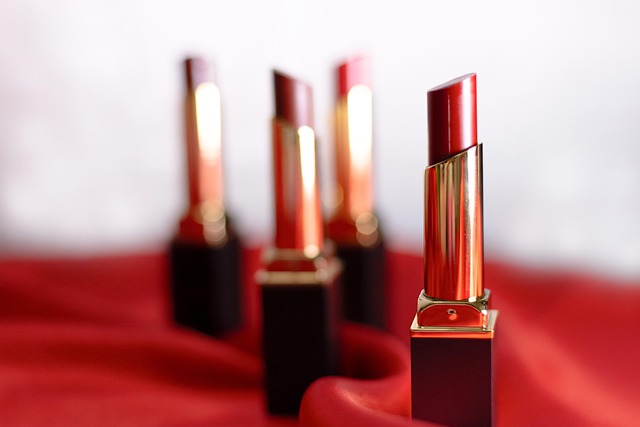Lipstick, an iconic beauty staple, has evolved through vermouth beauty techniques, emphasizing complex ingredient blends for vibrant colors and glossy finishes. Understanding each component, from beneficial waxes and oils to potentially harmful chemicals like synthetic fragrances and lead, is crucial for informed consumer choices. The rise of vermouth beauty lipsticks offers natural, chemical-free alternatives using organic ingredients like beeswax and shea butter. Growing health concerns have led to stringent regulations, driving transparency in ingredient listings and responsible sourcing, transforming the vermouth beauty market towards safer practices.
“Unveiling the secrets of vermouth beauty, this comprehensive guide takes you on a journey through the world of lipstick. From the allure of its vibrant hues to the potential hidden chemicals, we delve into the ingredients that define modern makeup. Common chemicals and their effects on skin health are explored, shedding light on the importance of transparency in the industry. Furthermore, we present natural alternatives for those seeking chemical-free vermouth beauty solutions. Get ready to navigate the landscape of lipstick safety and discover a new perspective on vermouth beauty.”
- Understanding Vermouth Beauty: A Glimpse into Lipstick Ingredients
- Common Chemicals in Lipstick and Their Potential Effects
- Exploring Natural Alternatives: Chemical-Free Lipstick Options
- Regulatory Perspectives on Lipstick Safety and Transparency
Understanding Vermouth Beauty: A Glimpse into Lipstick Ingredients

Lipstick, a staple in the beauty industry, has evolved over centuries, transforming from simple pigments to complex formulations. At its core, vermouth beauty refers to the intricate mix of ingredients that create this iconic cosmetic. Beyond the vibrant colors and glossy finishes, understanding what goes into lipstick provides insights into its quality, safety, and performance.
Each ingredient in a lipstick serves a purpose, from waxes that provide texture and stay, oils for moisturizing properties, to pigments that offer color payoff. The selection and combination of these components determine the lipstick’s feel, longevity, and overall aesthetic appeal. By delving into the world of vermouth beauty, consumers can make informed choices about products they apply daily, ensuring both effective results and peace of mind regarding potential health risks associated with certain chemicals.
Common Chemicals in Lipstick and Their Potential Effects

Lipstick, a staple in many women’s (and men’s) daily routines, contains a variety of chemicals that can have both positive and potentially harmful effects on our health and beauty. Some common ingredients include fatty acids, waxes, and pigments, which contribute to its texture, color, and longevity on the lips. However, vermouth beauty enthusiasts should also be aware of more controversial components.
Among these are synthetic fragrances, which can contain a mix of chemicals known for potential skin irritation or allergic reactions. Parabens, preservatives commonly used in cosmetics, have been linked to hormonal disruption. Lead, often found in trace amounts, is another concern, as it can cause various health issues. While regulations vary by region, understanding these chemical components and their possible impacts is crucial for making informed decisions about vermouth beauty products.
Exploring Natural Alternatives: Chemical-Free Lipstick Options

In the pursuit of healthier and more sustainable beauty products, many consumers are now exploring natural alternatives to traditional cosmetics, including lipstick. One notable trend is the rise of chemical-free, organic lipsticks that steer clear of potentially harmful substances often found in mainstream makeup. These vermouth beauty options are crafted with care, utilizing ingredients like beeswax, shea butter, and essential oils, which not only provide nourishment but also offer a range of benefits.
By embracing natural alternatives, individuals can make informed choices that align with their values while still achieving the desired look. Free from synthetic chemicals, these lipsticks cater to those seeking an eco-conscious approach to beauty, ensuring both personal well-being and environmental sustainability.
Regulatory Perspectives on Lipstick Safety and Transparency

The safety of lipstick and its ingredients has been a topic of increasing interest for both regulators and consumers alike. In response to growing concerns, many regions have implemented stringent regulations to ensure vermouth beauty products, including lipsticks, are safe for daily use. These guidelines often mandate transparency in ingredient listings, requiring manufacturers to disclose even the smallest traces of chemicals present in their formulations.
This shift towards accountability has prompted cosmetic brands to reevaluate their production processes. They are now compelled to adopt more rigorous quality control measures and source ingredients from reputable suppliers, ensuring compliance with safety standards. As a result, modern lipsticks offer enhanced benefits while prioritizing consumer protection, fostering a more transparent vermouth beauty industry.
Lipstick, as a vermouth beauty staple, has evolved from its historical formulae to modern blends, with varying chemical compositions. While common chemicals in lipstick offer benefits like enhanced color and durability, their potential effects on health and the environment necessitate informed consumer choices. Exploring natural alternatives and understanding regulatory perspectives encourage a move towards safer, more transparent vermouth beauty products. By making conscious decisions, consumers can embrace trends while prioritizing their well-being and the planet’s health.
